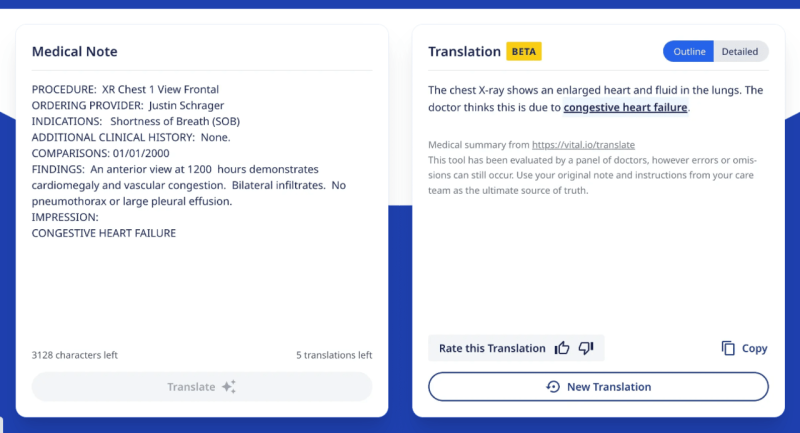Most patients have had those moments when they try to decipher their doctor's medical notes. Myalgia? Epistaxis? F/U? It can seem like a foreign language to a layperson.
Some people call family members who are doctors or nurses to get them to translate. For other patients, misunderstanding medical jargon can cause unnecessary stress.
Health tech company Vital launched an AI-powered doctor-to-patient translator to instantly turn highly technical medical terminology into plain language.
Vital used large language models and natural language processing to build its medical note translator, which is free and available to the public in English. It translates complex doctor's notes, radiologist reads, discharge summaries and test results into a 5th-grade reading level, according to Aaron Patzer, co-founder and CEO at Vital.

The 21st Century Cures Act requires all providers to release medical notes to patients, but doctors' clinical notes can be complex and confusing for patients, Patzer noted.
“In medical notes, it's not a ‘nosebleed’, it's ‘epistaxis,’ not a ‘stroke’ but a ‘cerebral infarction.’ Instead of writing ‘don't eat before surgery,’ doctors use the abbreviation ‘NPO.’ For people who aren't medically trained, misunderstanding medical jargon can result in unnecessary stress and poor health outcomes," he said.
The doctor-to-patient translator, which was unveiled at the Ai4 2023 conference in Las Vegas on Tuesday, benefits patients and clinicians, according to the company.
For providers, the tool increases access by elevating the level of health literacy for patients and other care team members—resulting in reduced workload, less time explaining diagnoses and treatments, and a reduced risk of miscommunication. For hospitals and health systems, the translator reduces the likelihood of adverse clinical events by involving the patient in their care plan and focusing their attention on high-impact interventions, such as medication compliance and follow-up adherence, executives said.
For patients, the translator tool requires no downloads or registration and is secure through Microsoft's reliable HIPAA- and HITRUST-compliant cloud.
The translator tool is an extension of Vital's work to use AI-based solutions for hospitals and health systems. Vital's ERAdvisor software for the emergency department and CareAdvisor solution for inpatient care settings are designed to improve communication between providers and patients.
Patzer, the founder of Mint.com, launched Vital in 2017 based on the premise that he could do for hospital emergency rooms what he did for banking and budgets: better organize data, patients and resources through easy-to-understand visualizations and cloud-based software.
Vital is a cloud-based software platform that sits on top of a hospital's existing electronic health record, according to the company. It uses AI and natural language processing to predict admissions hours in advance, reducing length of stay and saving hospitals time and money with improved ED flow. Essentially, the software can triage patients before they see a doctor, according to the company.
Its CareAdvisor software provides an individualized care experience for hospitalized patients and their families and powers clinical decision support for providers and hospital staff.
The company has raised $45.9 million to date, according to Crunchbase, backed by investors like Transformation Capital and Threshold Ventures.
Vital now works with 100 hospitals, and more than 1 million patients actively use the software, according to Patzer.
The new doctor-to-patient translator tool is available to hospitals and health systems that use Vital's ERAdvisor and CareAdvisor applications.
The company plans to expand the medical note translator tool to include native translation into Spanish by September and plans to make it available in other major languages by the end of the year, Patzer said.
"This is free to the public, frankly, because I just want to show that we're good at AI, and hope that health systems notice and buy our primary software. But, also, it's just a good thing to do," he said.
Vital took rigorous steps to assess the quality and safety of the doctor-to-patient translations, according to Patzer. As of July 2023, a panel of internal and external physicians studied nearly 2,000 translator outputs from real-world medical notes, finding that 99.4% of the translations were safe (will not lead to patient harm). Only 0.6% were marked as unsafe, in that they contained inaccurate information or were missing key information from the summary that could potentially cause patient harm.
"The fair comparison is not what about the 0.6%. It's, how well human doctors do when they're scanning through the notes," Patzer said, noting that AI has the potential to provide patients with clear, accurate information about their diagnosis or treatment.
“The doctor-to-patient translator has enormous potential to benefit patients, their loved ones, and their care teams,” said Kim Kilby, M.D., a participant of the physician review panel that reviewed the quality and accuracy of the translated medical notes. “Empowering patients to better understand their health is a key component of a good clinical outcome. Comprehension also allows the care team to become a more trusted and reliable partner in a patient's care.”
The Joint Commission has identified miscommunication between doctors and patients as a leading cause of sentinel events, the most serious adverse events. A recent study published in the Journal of Patient Satisfaction identified communication failures in nearly half of medical malpractice claims.
“As a practicing physician, I use specific and detailed medical terminology in my notes to communicate with my colleagues. This language was never intended to be used by my patients. I have seen firsthand how misinterpretations of the information in medical notes can cause confusion and distress for my patients,” said Justin Schrager, M.D., chief medical officer at Vital, in a press release.
“Even when information is explained several times, it can often fade from memory swiftly. This is particularly true when patients are fatigued or really not feeling well. Truly engaging patients in their care is achieved by ensuring they have a clear understanding of their condition and treatment plan," he said.